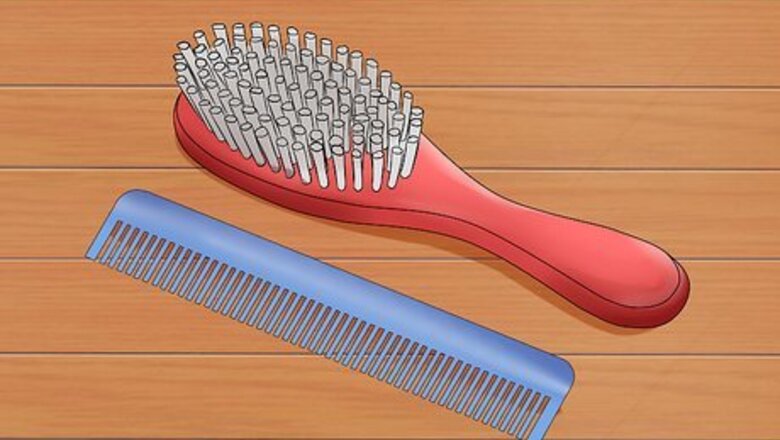
views
Brushing Your Maine Coon

Gather your supplies. You should brush your Maine Coon once a week. A good brushing helps a cat's fur stay smooth and soft and helps spread natural oils throughout the fur. Before you begin brushing your Maine Coon, you will need the following: You will need two different types of cat brushes, both of which can be purchased online or at a local pet supply store. You'll need a metallic comb for the first round of brushing. For the second round, you'll need a soft bristle or rubber brush. As Maine Coons are prone to matting, you'll need a sharp pair of scissors to cut out any unwanted mats that you can't brush out. You'll also need a fine-toothed comb to remove mats. You can use a regular comb for this process. You may want to get a rubber mat or rug of some kind. Maine Coons have a lot of hair. It's a good idea to brush them on a washable surface to help remove any loose hairs after grooming.

Ease your cat into a grooming routine. If your cat is new, he may not be used to being groomed. Start slow if you've never brushed your Maine Coon before. Grooming sessions should be fun. Wait for a moment when your cat seems relaxed and happy to start. Pet him for a little bit before you begin grooming in order to assure that he's calm going into the process. At first, keep your grooming sessions short. You may not be able to do a full grooming routine the first few times you brush your cat. Aim for 5 to 10 minutes of gentle brushing. If your cat seems distressed or upset, pause and pet him. Provide treats and other forms of positive reinforcement to keep the grooming routine fun.
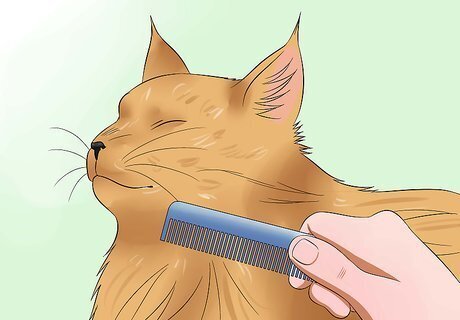
Use the metal comb first. The Maine Coon's coat has two layers: an undercoat and an overcoat. Two rounds of brushing are best for the Maine Coon's appearance. Start with the metal comb. Work from the head to tail. Go slowly, especially if your cat is distressed during the process. Move the comb gently as you do not want to puncture your cat's skin. Make sure to get the cat's belly and legs. Longhaired cats, like the Maine Coon, tend to get a long of tangles in these areas. Go slowly and be extra gentle when working knots out of these areas. Cats tend to dislike having their bellies and legs handled. If your cat is new to grooming, it may take a few practice grooming sessions before he'll be ready to let you groom these areas. Get your Maine Coon's tail as well. Make a part down the middle of the tail and then brush the fur on either side.
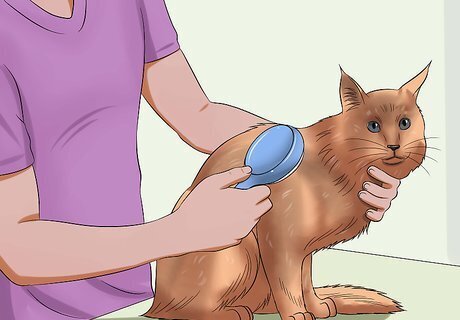
Move onto the bristle or rubber brush. Once you're done brushing with the metal brush, use the bristle or rubber brush to remove dead fur. Brush the fur in an upward motion, as this will help you address both layers of the Maine Coon's coat. Once again, be gentle as you go and go slowly over sensitive areas like the legs and stomach.
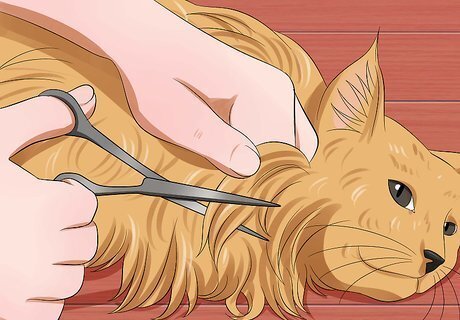
Clip out any mats. Due to their long hair, Maine Coons are prone to matting. While the best course of action is to try to work out tangles when brushing, some mats will not come out this way. You'll need to cut them out. If your cat is skittish, consider enlisting a friend for help during this process. You should clip out mats whenever you encounter them. If you brush your Maine Coon weekly, you're less likely to encounter mats. If you're working with a helper, have your helper pet and stroke the cat to keep him calm. Use your fine-toothed comb to create a barrier between the cat's skin and the mat. Be careful not the pull the cat's skin. A cat may become aggressive and squirm when hurt, making the process of clipping the mats more difficult. Clip out the mat quickly. Your cat will probably dislike having a comb stuck in him and may try to run away. Therefore, try to trim the mat swiftly. However, move slow enough that you maintain control of your scissors. You do not want to accidentally cut your cat's skin. If your cat starts to become aggressive, engaging in behavior like hissing and growing, take a break. You can clip out the rest of the mats later.
Bathing Your Cat
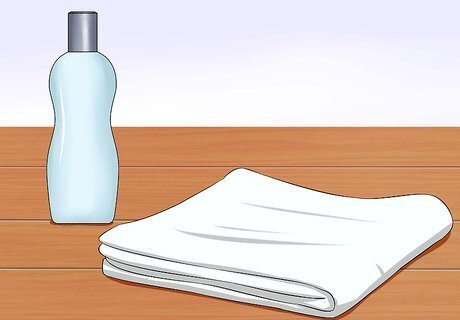
Gather your supplies. While most cats do not need regular bathing, longhaired cats like the Maine Coon may benefit from baths every few months. Their longer fur is more susceptible to holding onto dirt and debris, especially if you allow your cat to go outside. Before you begin bathing your Maine Coon, get all your supplies laid out. Once you being the bathing process, you may not have time to pause and grab supplies. Find someone to help you. Most cats, even well-trained cats, dislike bathing so you'll need a friend or family member to assist during this process. Find a high-quality cat shampoo. You can purchase cat shampoo online, at a local pet supplies shop, or at your veterinarian's office. If your cat has any specific health conditions that affect his skin or fur, ask your vet for a recommendation. You will need towels to dry your cat, a cup or bucket for pouring water over him, and a rubber mat to place on the bottom of the bath tub. This prevents the cat from slipping.
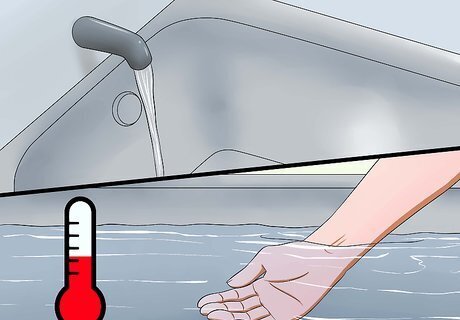
Prepare the tub. Fill the tub or sink about 3 to 4 inches full of water. Use a lukewarm temperature, neither too hot or too cold for your cat's comfort.
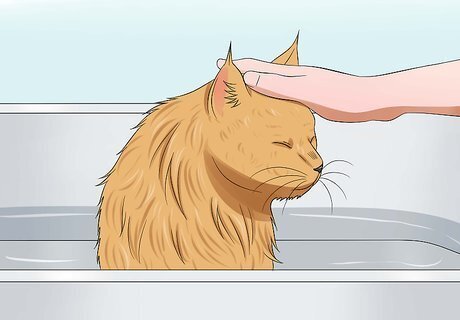
Ease your cat into the tub. Most cats will not climb willingly into water. You will likely have to pick him up and place him in the tub. Pet him and talk to him in a soft, gentle voice as you pick him up. If he squirms, have your helper assist you in holding him. Pet him as you ease him into the water. Try using treats for positive reinforcement.
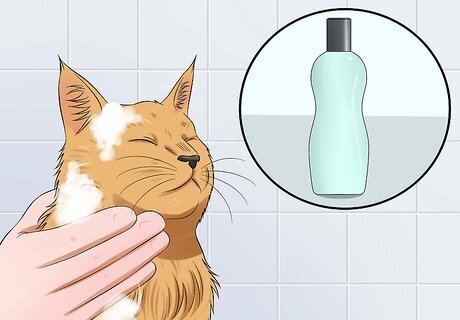
Wet your cat and apply shampoo. Once your cat is in the tub, you'll get his fur wet and then apply shampoo. Take your time during this process to make sure your cat is washed completely. A Maine Coon's fur does not get get wet easily. Use your cups or buckets to pour water over your cat's body until he's damp. It may take awhile due to the thick nature of the fur. Once your cat is wet, apply shampoo. Add a small amount to your hands and gently massage the shampoo in until it lathers. Move from head to tail and do not neglect places like the stomach and legs. Go slowly around the face to avoid getting shampoo into your cat's eyes. Add more water as needed when you shampoo. You may find, during the process, you need a bit more water to get the shampoo to lather.
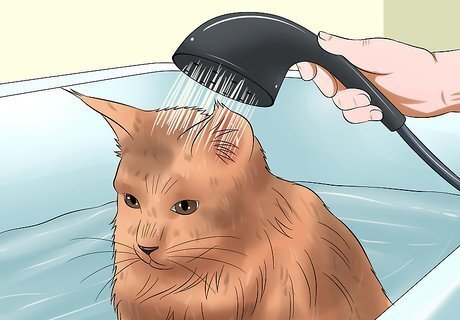
Rinse. Once your cat is shampooed, rinse him off. Use fresh, lukewarm water from the faucet. Your cat will likely be licking at his fur after the bath, so make sure all the shampoo is out. Keep rinsing until you no longer see suds or residue coming from your cat's fur. Make sure you remember to splash water on the stomach and legs as well. If you're unsure if a cat is fully rinsed, you can squeeze a small bit of fur and watch for suds.

Make sure your cat is dry. Once the rinsing process is done, allow your cat to climb out of the tub. Use a towel to dry him thoroughly. Wrap your cat up in a towel and rub his fur as dry as possible. Using a hairdryer is likely to startle your cat, so avoid this option. Once your cat is relatively dry, give him some space. Do not let him go outside until his fur has air dried completely.
Clipping Your Cat's Nails
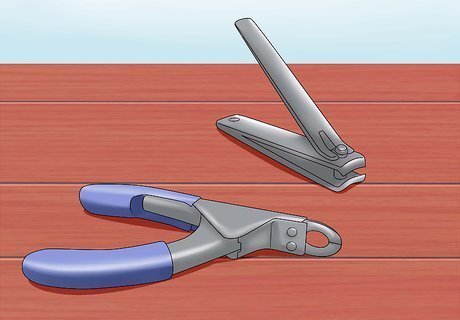
Choose your clippers. You can use regular nail clippers, a type of clipper modified to hold your cat's paw in place, or guillotine style clippers. Guillotine clippers work by inserting the claw into a small hold and then pushing the blade downward to make the cut. Your style of nail clipper depends on your personal preference. Choose a type of clipper you feel comfortable maneuvering. If you have a more skittish cat, you may want to get the modified clippers that will help hold his paw in place.

Find someone to help you hold your Maine Coon. Your cat may dislike having his claws clipped. Therefore, it's best to have a friend assist you. Ask a friend told hold your cat in place, pet him, and soothe him as you begin the process of trimming his claws. In the event you can't find someone to help you, you can try resting your cat in the crook of your arm while using your other hand to clip his claws. If your cat is more docile, you may be able to clip his claws on your own.

Take a small amount off the tip of the nails. Trim one paw at a time. Trim only a small amount of your cat's claws, taking off only the top tip. Do one paw at a time. Gently squeeze your cat's paw between your thumb and index finger so his claws extend. Then, begin trimming. There is a small pink portion on your cat's nail. This is called the quick. You should not trim into the quick as it's very sensitive and will bleed if cut. As you trim your cat's nails, stay well above the quick. In the event you accidentally trim the quick, dip the cat's claw in a bit of cornstarch or styptic powder. Then, rub the claw against a dry bar of soap.
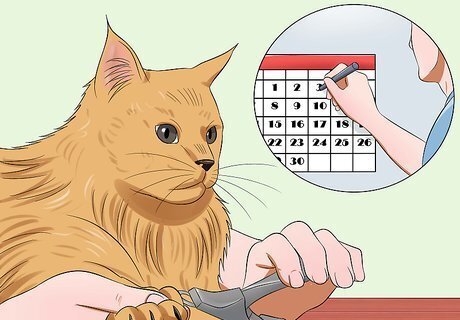
Do more than one trimming session if necessary. If you've never trimmed your Maine Coon's nails before, you might have to do more than one trimming session. If your cat gets aggravated and begins squirming, growling, or hissing, it's best to let him take a break. You can try to finish later when your cat is calmer.
Moving Forward
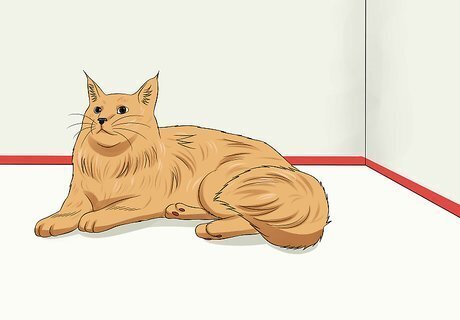
Give your cat space after grooming. Grooming can be a stressful experience, especially if your cat is new to the process. It might be a good idea to leave your cat alone for a few hours after grooming. He may need some time alone to calm down after being brushed, bathed, or having his nails trimmed. Praise your cat directly after grooming, providing positive reinforcement in the form of treats and praise, and then allow him to have some time to himself.
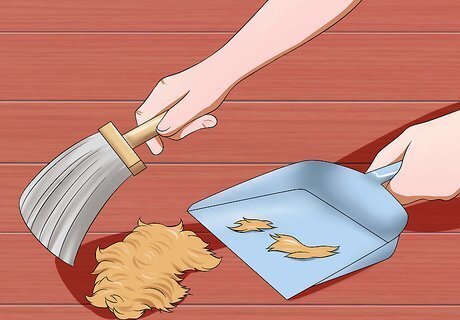
Clean up loose hairs and fur. When you get done bathing or brushing your cat, clean up any loose furs or hairs. Your cat might lick or swallow stray furs he finds on the floor, which can lead to hairballs. Sweep the grooming area thoroughly after grooming your Maine Coon to prevent this problem.
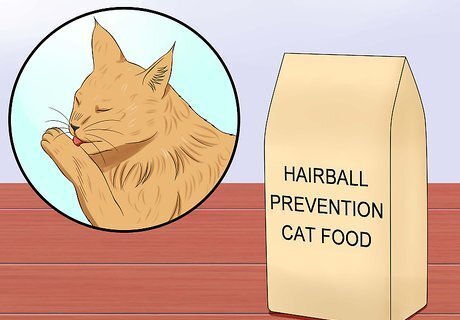
Address hairballs. Maine Coons are prone to hairballs due to their long fur. Regular grooming can prevent hairballs. However, if your cat continues to have issues with hairballs despite frequent brushing and bathing, consider adjusting his diet. Look into cat foods specifically designed to reduce hairball production. You can buy many hairball control cat foods at your local supermarket. Ask your vet for a recommendation if you're unsure what brand to try. Ingredients like avocado oil and other vegetable and fruit oils may help reduce hairballs in cats. Look for these ingredients when purchasing a new brand of cat food.




















Comments
0 comment